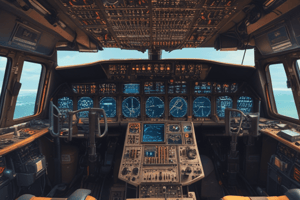Podcast
Questions and Answers
What is a key difference between Type 3 systems and other systems?
What is a key difference between Type 3 systems and other systems?
- They can memorise failure messages.
- They have a multifunction control display unit.
- They have a discrete output.
- They cannot memorise failure messages. (correct)
What is the primary function of the Central Maintenance Computers (CMCs)?
What is the primary function of the Central Maintenance Computers (CMCs)?
- To initialise the dialogue with the MCDUs.
- To acquire and process information from aircraft systems. (correct)
- To store data concerning aircraft systems in non-volatile memories.
- To display data on the Multifunction Control Display Unit.
What is the purpose of guided tests in the MCDU?
What is the purpose of guided tests in the MCDU?
- To initialise the dialogue with the CMCs.
- To perform self-tests on aircraft systems.
- To display data on the Multifunction Control Display Unit.
- To perform fault-finding on aircraft systems. (correct)
How do the CMCs store data concerning aircraft systems?
How do the CMCs store data concerning aircraft systems?
What is the function of the line keys on the Multifunction Control Display Unit?
What is the function of the line keys on the Multifunction Control Display Unit?
How do operators access the CMC functions?
How do operators access the CMC functions?
What is the consequence of a Class 2 failure on the current flight?
What is the consequence of a Class 2 failure on the current flight?
Where are Class 3 failures only available?
Where are Class 3 failures only available?
What is the primary function of Type 1 system computers?
What is the primary function of Type 1 system computers?
What is the output connection of Type 2 system computers?
What is the output connection of Type 2 system computers?
How do Type 1 system computers connect to the CMCs?
How do Type 1 system computers connect to the CMCs?
What is the purpose of the ECAM STATUS page?
What is the purpose of the ECAM STATUS page?
What is the primary purpose of the ARINC 429 link between CMC 1 and CMC 2?
What is the primary purpose of the ARINC 429 link between CMC 1 and CMC 2?
What type of failures are displayed as a warning in real-time on the ECAM and are available on the MCDU?
What type of failures are displayed as a warning in real-time on the ECAM and are available on the MCDU?
What is the purpose of the CMC recording failure information and messages in a non-volatile memory system?
What is the purpose of the CMC recording failure information and messages in a non-volatile memory system?
What happens to warnings displayed on the ECAM display unless they are cancelled?
What happens to warnings displayed on the ECAM display unless they are cancelled?
What is the function of the flight warning computers?
What is the function of the flight warning computers?
What is the primary function of the ECAM display?
What is the primary function of the ECAM display?
What is the primary characteristic of a Class 1 EFB system?
What is the primary characteristic of a Class 1 EFB system?
Which type of EFB system requires administrative control before use?
Which type of EFB system requires administrative control before use?
What is a key difference between Class 1 and Class 2 EFB systems?
What is a key difference between Class 1 and Class 2 EFB systems?
What is the primary use of an Electronic Flight Bag (EFB) system?
What is the primary use of an Electronic Flight Bag (EFB) system?
What is an alternative term for a Class 1 EFB system?
What is an alternative term for a Class 1 EFB system?
What document contains descriptions of EFB classes?
What document contains descriptions of EFB classes?
What enables ground support personnel to interface directly with the server from outside the aircraft?
What enables ground support personnel to interface directly with the server from outside the aircraft?
What is the primary function of the LoadStar software?
What is the primary function of the LoadStar software?
What is the name of the on-board data loaders on later-generation Boeing aircraft?
What is the name of the on-board data loaders on later-generation Boeing aircraft?
What is the dual Operating System (OS) software supported by the PMAT/NT?
What is the dual Operating System (OS) software supported by the PMAT/NT?
What connects to the back of the Portable Data Loaders (PDL) and supplies the airplane with ARINC data buses?
What connects to the back of the Portable Data Loaders (PDL) and supplies the airplane with ARINC data buses?
What is the name of the on-board data loaders on Airbus aircraft?
What is the name of the on-board data loaders on Airbus aircraft?
Flashcards are hidden until you start studying
Study Notes
Key Differences between Type 3 and Other Systems
- Type 3 systems are distinguished by their specific operational limitations compared to Type 1 and Type 2 systems.
Central Maintenance Computers (CMCs) Functions
- CMCs monitor and diagnose aircraft systems, ensuring optimal operation and safety.
- They store crucial data about aircraft systems in non-volatile memory for reliability.
Guided Tests in the MCDU
- Guided tests assist operators in troubleshooting and maintaining aircraft systems effectively.
CMC Data Storage
- CMCs utilize non-volatile memory to retain aircraft systems data, ensuring preservation during power loss.
Multifunction Control Display Unit (MCDU) Line Keys
- Line keys allow operators to interact with various operations within the MCDU, facilitating system management.
Accessing CMC Functions
- Operators can access CMC functions through the MCDU interface, simplifying control and monitoring.
Consequences of Class 2 Failures
- A Class 2 failure can affect flight operations but typically does not compromise safety or necessitate immediate action.
Class 3 Failures Availability
- Class 3 failures are specific to maintenance scenarios and typically not presented during regular flight operations.
Primary Function of Type 1 System Computers
- Type 1 systems are responsible for critical flight control and navigation tasks.
Type 2 System Computers Output Connection
- Type 2 system computers connect to multiple data buses for transmitting vital information.
Type 1 System Computers Connectivity to CMCs
- They connect to CMCs through dedicated communication links for data exchange.
ECAM STATUS Page Purpose
- The ECAM STATUS page provides real-time information regarding the current health and status of aircraft systems.
ARINC 429 Link Functionality
- The primary function is to ensure reliable data exchange between CMC 1 and CMC 2, enhancing redundancy and system integrity.
Real-Time Warnings on ECAM and MCDU
- Failures such as engine warnings and system malfunctions are displayed in real-time for immediate awareness.
CMCs Non-Volatile Memory System
- Recording failure information in a non-volatile memory system ensures that critical data is retrievable even after power loss.
Warnings on ECAM Display
- Warnings displayed remain active until explicitly canceled, ensuring continuous alertness to potential issues.
Flight Warning Computers Function
- They analyze aircraft data to detect and warn of anomalies affecting flight safety and performance.
Primary Function of ECAM Display
- The ECAM displays operational data and alerts, aiding pilots in monitoring aircraft performance.
Class 1 EFB System Characteristic
- Features primarily support flight operations without direct administrative control for use.
Administrative Control Requirement for EFB Systems
- Class 2 EFB systems require administrative control before they can be utilized in operational scenarios.
Class 1 vs. Class 2 EFB Systems
- Class 1 systems do not require pre-approval for use, while Class 2 systems mandate specific administrative oversight.
Primary Use of Electronic Flight Bag (EFB) System
- EFB systems are mainly employed to manage flight-related documents and improve cockpit efficiency.
Alternative Term for Class 1 EFB
- Some refer to Class 1 EFB systems as Portable Electronic Flight Bags (PEFB).
Document Describing EFB Classes
- The guidelines that outline EFB classes are typically detailed in aviation regulatory documentation.
Ground Support Personnel Interface
- Remote access to the aircraft's server enables ground support personnel to perform diagnostics and updates.
LoadStar Software Function
- LoadStar software is responsible for loading and managing flight data efficiently across various systems.
On-Board Data Loaders on Boeing Aircraft
- Latest Boeing aircraft utilize Dedicated Data Loaders for crucial data management tasks.
Dual Operating System Software
- PMAT/NT supports two different operating systems for versatile operational capabilities.
Connections for Portable Data Loaders (PDL)
- PDLs connect to aircraft systems through ARINC data buses, facilitating data transfer.
On-Board Data Loaders on Airbus Aircraft
- Airbus employs specific data loading systems designed for their aircraft models to streamline data management.
Studying That Suits You
Use AI to generate personalized quizzes and flashcards to suit your learning preferences.


